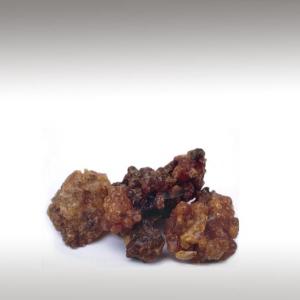
MYRRH GUM (COMMIPHORA MYRRHA) - INGREDIENTS

BASE / GENERAL DATA
Information submited: September 17, 2014 Modified: June 4, 2018 By: OperaDreamhouse
Myrrh is the aromatic resin of a number of small, thorny tree species of the genus Commiphora. Myrrh resin is a natural Gum.
When a tree wound penetrates through the bark and into the sapwood, the tree bleeds a resin. Myrrh Gum, like Frankincense, is such a resin. When people harvest Myrrh, they wound the trees repeatedly to bleed them of the Gum.
Myrrh Gum is waxy, and coagulates quickly. After the harvest, the Gum becomes hard and glossy. The Gum is yellowish, and may be either clear or opaque. It darkens deeply as it ages, and white streaks emerge.
Myrrh Gum is commonly harvested from the species Commiphora Myrrha, which is native to Yemen, Somalia, Eritrea and eastern Ethiopia. Another commonly used name, Commiphora Molmol, is now considered a synonym of Commiphora Myrrha. The related Commiphora Gileadensis, native to Eastern Mediterranean and particularly the Arabian Peninsula, is the biblically referenced Balm of Gilead, also known as Balsam of Mecca. The word “Myrrh” derives from the the Aramaic (Murr), meaning “Was Bitter”.
Myrrh is the aromatic oleoresin of a number of small, thorny tree species of the genus Commiphora, which grow in dry, stony soil. An oleoresin is a natural blend of an essential oil and a resin.
So valuable has it been at times in ancient history that it has been equal in weight value to gold. During times of scarcity, its value rose even higher than that. It has been used throughout history as a perfume, incense, medicine and spiritual practice.
Little appears to be definitely known about the collection of Myrrh. It seems probable that the best drug comes from Somaliland, is bought at the fairs of Berbera by the Banians of India, shipped to Bombay, and there sorted, the best coming to Europe and the worst being sent to China.
When a tree wound penetrates through the bark and into the sapwood, the tree bleeds a resin. Myrrh Gum, like Frankincense, is such a resin. When people harvest Myrrh, they wound the trees repeatedly to bleed them of the Gum.
Myrrh Gum is waxy, and coagulates quickly. After the harvest, the Gum becomes hard and glossy. The Gum is yellowish, and may be either clear or opaque. It darkens deeply as it ages, and white streaks emerge.
Myrrh Gum is commonly harvested from the species Commiphora Myrrha, which is native to Yemen, Somalia, Eritrea and eastern Ethiopia. Another commonly used name, Commiphora Molmol, is now considered a synonym of Commiphora Myrrha. The related Commiphora Gileadensis, native to Eastern Mediterranean and particularly the Arabian Peninsula, is the biblically referenced Balm of Gilead, also known as Balsam of Mecca. The word “Myrrh” derives from the the Aramaic (Murr), meaning “Was Bitter”.
Myrrh is the aromatic oleoresin of a number of small, thorny tree species of the genus Commiphora, which grow in dry, stony soil. An oleoresin is a natural blend of an essential oil and a resin.
So valuable has it been at times in ancient history that it has been equal in weight value to gold. During times of scarcity, its value rose even higher than that. It has been used throughout history as a perfume, incense, medicine and spiritual practice.
Little appears to be definitely known about the collection of Myrrh. It seems probable that the best drug comes from Somaliland, is bought at the fairs of Berbera by the Banians of India, shipped to Bombay, and there sorted, the best coming to Europe and the worst being sent to China.
The true Myrrh is known in the markets as Karam, formerly called Turkey Myrrh, and the opaque bdellium as Meena Harma.

SPIRITUAL PRACTISES DATA

MEDICINE / HEALTH DATA

BEAUTY / COSMETICS DATA

FOOD / COOKING DATA
COMMENTS
No comments.


